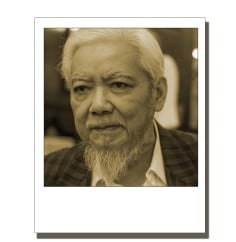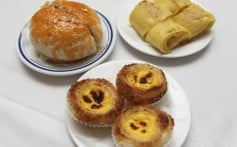
Taking a bite out of two worlds
Hong Kong was doing fusion food way before it was fashionable. The result is pork chop on spaghetti and milk tea ... and a cuisine that's all our own

Up until about 20 years ago, Britain had a bad reputation for its food, around the world and at home. Many people considered it stodgy, underseasoned and unimaginative. The writer W.Somerset Maugham supposedly said: "To eat well in England, you should have breakfast three times a day" - although their afternoon tea is also very good.

"The British influence on Chinese food dates back to the 19th century," says William Mark Yiu-tong, as he carefully dissects a dai bao, or big bun, at his regular table at Luk Yu Tea House on Stanley Street in Central. Turning the bun upside-down, he eats the bottom first, saying: "This is the best part because all the [meat] juices have soaked into the [steamed bread]."
Mark, who was born in 1936, has spent much of his adult life promoting Chinese cuisine, as a journalist, an author of cookbooks, a restaurant consultant and president of the Federation of Hong Kong Restaurant Owners.
The jovial foodie first visited Luk Yu more than 60 years ago - the restaurant celebrates its 80th anniversary this year - and now eats dim sum there every day.
He continues: "Chinese [cooks] borrowed British ideas for dishes, but used Chinese ingredients. What they made was not the same, but it is something similar.
"Most [Chinese] restaurants in Hong Kong serve, to a certain extent, fusion food. It's nothing new. Take Luk Yu - it started serving fusion food right from the beginning; it has been serving the same old thing for 80 years.
"In the 1930s, competition among teahouses was very strong, so they kept introducing new items. Other than [traditional] Chinese dim sum, they grabbed ideas from Britain. That is why there is such a strong Western influence in Hong Kong and Cantonese dim sum.
"In the rest of China, the dim sum is very traditional - dumplings, buns and [steamed] cakes, that's it. There's not much variety, unlike in Hong Kong and Macau."
Along with traditional items such as har gau (shrimp dumplings) and siu mai (pork and shrimp dumplings), Luk Yu also serves char siu so (barbecued pork buns wrapped in flaky pastry), and egg tarts.

"These types of dishes came about as the Chinese tried to make English food," he says. "It's the British influence - pancake, pie and tart. In the old days, upper-class Chinese thought it fashionable to copy the English way of living. They took English food and put a Chinese twist to it.
"And, as is often the way with culture, it filtered down [to the masses]. It took decades to filter down."
Many of the iconic dishes we take for granted in Hong Kong have their roots in English cuisine - although if you showed them to the English, they probably would not recognise them as such.
With tea, for instance, the British (in novels and on film, anyway) brew it in pretty teapots, pour it into delicate cups, stir in a little fresh milk, and sip - with their pinkies sticking out - while nibbling on scones and tiny cakes, pastries and sandwiches.
You can get this type of genteel afternoon tea at many restaurants in the city, particularly those in hotels.
However, you can also have a uniquely Hong Kong type of tea: lai cha, or milk tea, is consumed by diners sitting under fluorescent lights at crowded tables in a cha chaan teng, or tea cafe.
The beverage is made by cooks who simmer strong black tea, mix in evaporated milk and filter it through a fine cloth sieve to make it smooth, before serving it in a sturdy white teacup or a heatproof glass.
Diners add spoonfuls of sugar, then pair it with snacks, such as toast drizzled with condensed milk or a pineapple bun with a thick, cold slice of margarine or butter.
" Lai cha has an English influence - the Chinese don't normally pollute their tea with milk," Mark says with a laugh.
"Pastry, with dim sum in particular, has a very strong British influence. Daan taat [egg tart] didn't exist before the Brits came to Hong Kong."
Mark complains about the difficulty of finding a good steak and kidney pie or mature Stilton, an English blue cheese, in the city following Hong Kong's return to China in 1997. He does, however, recommend the steak and kidney pie served at the Foreign Correspondents' Club.
He then goes on to reminisce: "I remember back in the late '40s, a mixed grill from Jimmy's Kitchen was HK$7. That was a lot of money - at the time, a bowl of wonton noodles was 50 cents per bowl. This was just after the war. Back then, [Sino-British food] was a luxury."
WHERE TO FIND SINO-BRITISH FOOD
Jimmy's Kitchen
G/F South China Building, 1-3 Wyndham Street, Central (tel: 2526 5293); G/F Kowloon Centre, 29 Ashley Road, Tsim Sha Tsui (tel: 2376 0327)
At Jimmy's Kitchen, you'd never know there had been a British food revolution, but that's how their customers like it. Here, you can have fish and chips and Sunday roast and beef Wellington served alongside shrimp and mango salad and beef fried rice.
Tai Ping Koon
60 Stanley Street, Central (tel: 2899 2780); 6 Pak Sha Road, Causeway Bay (tel: 2576 9161); 40 Granville Road, Tsim Sha Tsui (tel: 2721 3559); 19-21 Mau Lam Street, Yau Ma Tei (tel: 2384 3385)
This small chain is most famous for its Swiss chicken wings (which are not Swiss at all; they're braised in a soy sauce-based marinade). You can also find baked escargot served over rice, mixed grill with garlic sauce, and seafood with cream sauce and spaghetti.
Sammy's Kitchen
204-206 Queen's Road West, Sheung Wan (tel: 2548 8400)
At Sammy's, the ox tongue with sauce is ladled over spaghetti, lamb chops are smothered in a sweet onion sauce, and many other meats are served with "Sammy's special sauce" made with Cointreau, port, tomatoes and onion.

24 Stanley Street, Central (tel: 2523 5464)
Step back in time when you enter Luk Yu, which has ceiling fans, soft lighting and wooden panels. For Sino-British fusion dishes, try the baked duck pie, barbecued pork pastry and canned peach pancakes. The egg tarts are done in the Portuguese style, and are warm from the oven and very delicious.